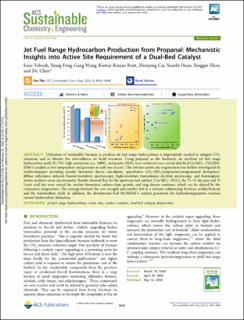| dc.contributor.author | Yeboah, Isaac | |
| dc.contributor.author | Feng, Xiang | |
| dc.contributor.author | Wang, Gang | |
| dc.contributor.author | Rout, Kumar Ranjan | |
| dc.contributor.author | Cai, Zhenping | |
| dc.contributor.author | Duan, Xuezhi | |
| dc.contributor.author | Zhou, Xinggui | |
| dc.contributor.author | Chen, De | |
| dc.date.accessioned | 2022-05-25T12:10:44Z | |
| dc.date.available | 2022-05-25T12:10:44Z | |
| dc.date.created | 2020-11-10T22:54:37Z | |
| dc.date.issued | 2020 | |
| dc.identifier.citation | ACS Sustainable Chemistry and Engineering. 2020, 8 9434-9446. | en_US |
| dc.identifier.issn | 2168-0485 | |
| dc.identifier.uri | https://hdl.handle.net/11250/2996248 | |
| dc.description.abstract | Utilization of sustainable biomass to produce jet fuel range hydrocarbons is imperatively needed to mitigate CO2 emissions and to liberate the over-reliance on fossil resources. Using propanal as the feedstock, an excellent jet fuel range hydrocarbon yield (81.7%), high conversion (ca. 100%), and purity (85%) were achieved over a novel dual-bed Cu/SiO2–TiO2||Ni/ZSM-5 catalyst at low temperature and pressure in only one reactor. The intrinsic active site requirement was further investigated by multitechniques including density functional theory calculation, quantitative CO2/NH3-temperature-programmed desorption/diffuse reflectance infrared Fourier-transform spectroscopy, high-resolution transmission electron microscopy, and thermogravimetric analysis–mass spectrometry. Results showed that for the upstream bed catalyst (Cu/SiO2–TiO2), the Ti–O site pair and Ti Lewis acid site were crucial for enolate formation, carbon-chain growth, and ring closure reactions, which can be altered by the calcination temperature. The synergy between the site strength and number led to a volcanic relationship between acidity/basicity and the intermediate yield. In addition, the downstream bed Ni/HZSM-5 catalyst promoted the hydrodeoxygenation reaction toward hydrocarbon formation. | en_US |
| dc.language.iso | eng | en_US |
| dc.publisher | American Chemical Society | en_US |
| dc.rights | Navngivelse 4.0 Internasjonal | * |
| dc.rights.uri | http://creativecommons.org/licenses/by/4.0/deed.no | * |
| dc.subject | Oxides | en_US |
| dc.subject | Hydrocarbons | en_US |
| dc.subject | Fuels | en_US |
| dc.subject | Catalysts | en_US |
| dc.subject | Carbon | en_US |
| dc.title | Jet fuel range hydrocarbon production from propanal: Mechanistic insights into active site requirement of a dual-bed catalyst | en_US |
| dc.type | Peer reviewed | en_US |
| dc.type | Journal article | en_US |
| dc.description.version | publishedVersion | en_US |
| dc.rights.holder | Copyright © 2020 American Chemical Society. This is an open access article published under a Creative Commons Attribution (CC-BY) License, which permits unrestricted use, distribution and reproduction in any medium, provided the author and source are cited | en_US |
| dc.source.pagenumber | 9434-9446 | en_US |
| dc.source.volume | 8 | en_US |
| dc.source.journal | ACS Sustainable Chemistry and Engineering | en_US |
| dc.identifier.doi | 10.1021/acssuschemeng.0c02200 | |
| dc.identifier.cristin | 1846746 | |
| dc.relation.project | Norges forskningsråd: 257622 | en_US |
| cristin.ispublished | true | |
| cristin.fulltext | original | |
| cristin.qualitycode | 1 | |

